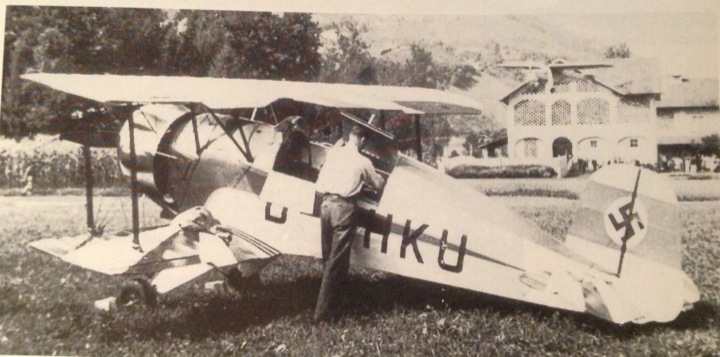Brian Karli Researched the matter and dug up some interresting history:
Great photos and story! More than likely, the Jungmeister did not survive the war. After doing some research, I have found there are no original German Jungmeisters remaining today. They are all Swiss or Spanish airframes. Unfortunately, surplus German war material was broken up for scrap right after the war. My guess is that the Jungmeister met the same fate. It's a shame, though. Think of what might have been...
Anyway, I found out a lot about Albert Falderbaum.
Your dad was right. Albert Falderbaum was the German Aerobatic Champion in 1938 and 1939 flying Jungmeister D-EQOA. He also flew Jungmeister D-EHKU. Could the Jungmeister behind your dad be one of these airplanes? Before the war, all the Jungmeisters were owned by the German National Flying club Deutsche Luftsportverband. Since there weren't that many Jungmeisters, undoubtedly Albert flew all of them.
Albert Falderbaum came from a sporting family and grew up in Niederpleis, Germany. At an early age, he developed a love of flying by building model airplanes. From the age of 14 he began soaring in Bonn.
In 1934, Albert joined the German Air Force. He used this opportunity to develop his skills in aerobatics. During the 1937 German Aerobatic Championships in Dortmund, Albert came in second place.
The next year, Albert came in first place and again in 1939 despite feeling the effects of an acute appendicitis.
During the war, Albert continued his work as a flight instructor, the focus of his work was in the blind flying training of pilots. As the war drew to a close, Albert flew the rocket powered ME163 and jet powered ME262. He became the Staffelkaptan of Erganzungsstaffel JG400 and eventually Gruppenkommanueur in February 1945. During this time he suffered a serious back injury when his aircraft exploded.

After the war, private flying was banned in Germany. Albert took a job in the chemical business but not to be deterred, Albert continued flying in Switzerland. When flying was allowed again 1955, Albert began giving aviation demonstrations and became the German Aerobatic champion again in 1960...flying a Jungmeister.
He continued to fly airshows throughout Europe. Here is a link showing Albert flying a glider inverted down a runway. Unfortunately, he clipped the tail!
http://www.britishpathe.com/video/glider-crash
1955 - Air field at Dusseldorf, with Albert Falderbaum's glider as it takes off. CU. Spectators watching. GV. Glider flying swiftly upside down just above the ground - the tail of the glider touches the ground and it is torn off.
Albert ended up in a coma for 14 days!
Unfortunately, my research yielded Albert's death. He was employed as a test pilot for a new sport aircraft, the Siebel Siat 222. On September 29th 1961, he took off from the airfield in Augsburg to conduct spin testing. Unable to recover, Albert bailed out but his parachute snagged the tail and pulled him to the ground. He was 48 years old.
Looking at these pictures of Albert, notice the coloration around the cowl bumps. The same coloration is seen on your dad's Jungmeister picture. Perhaps this is D-EHKU after all?
Anyway, it was fun researching a piece of Bucker history. Thanks for sharing your dad's pictures.
Brian

